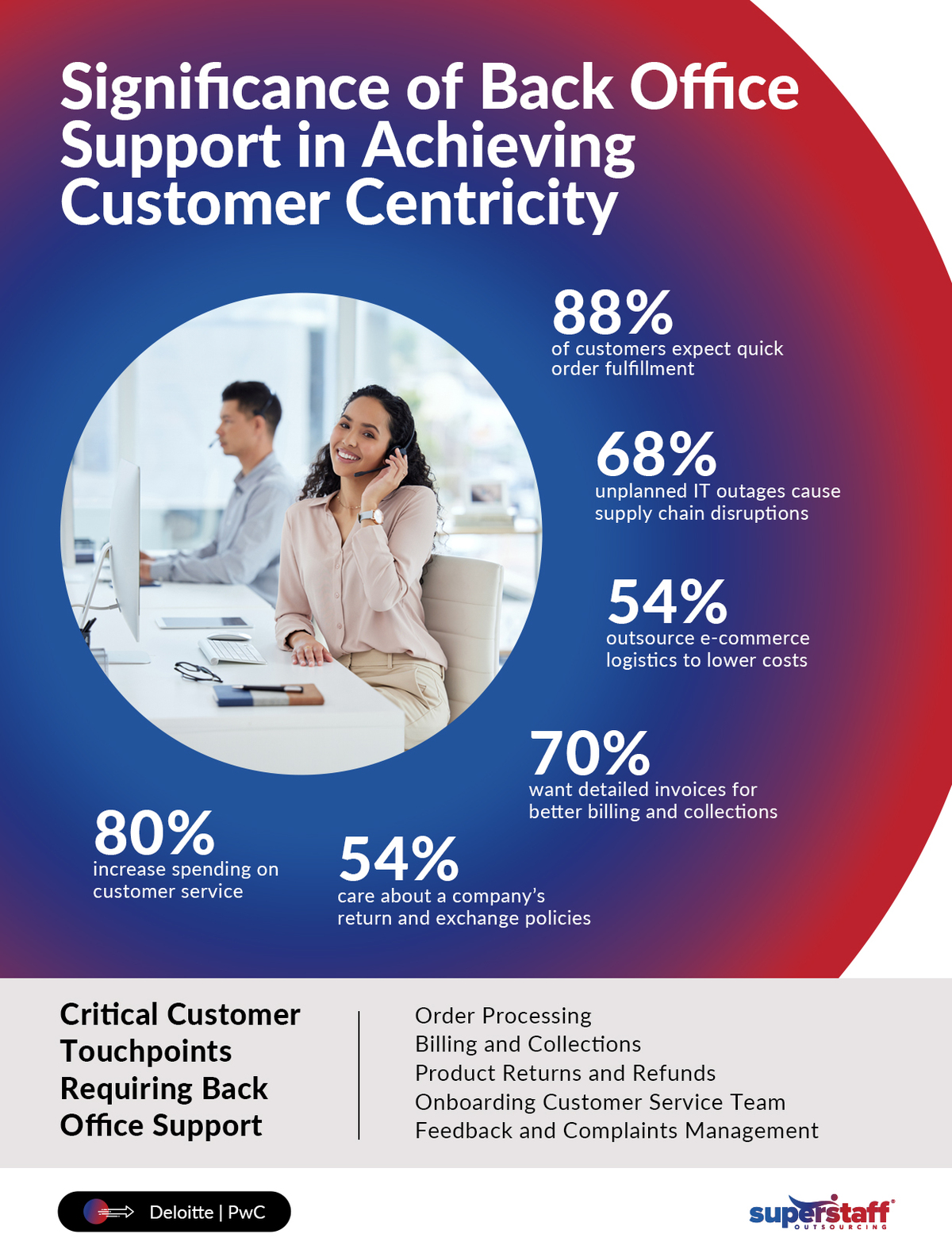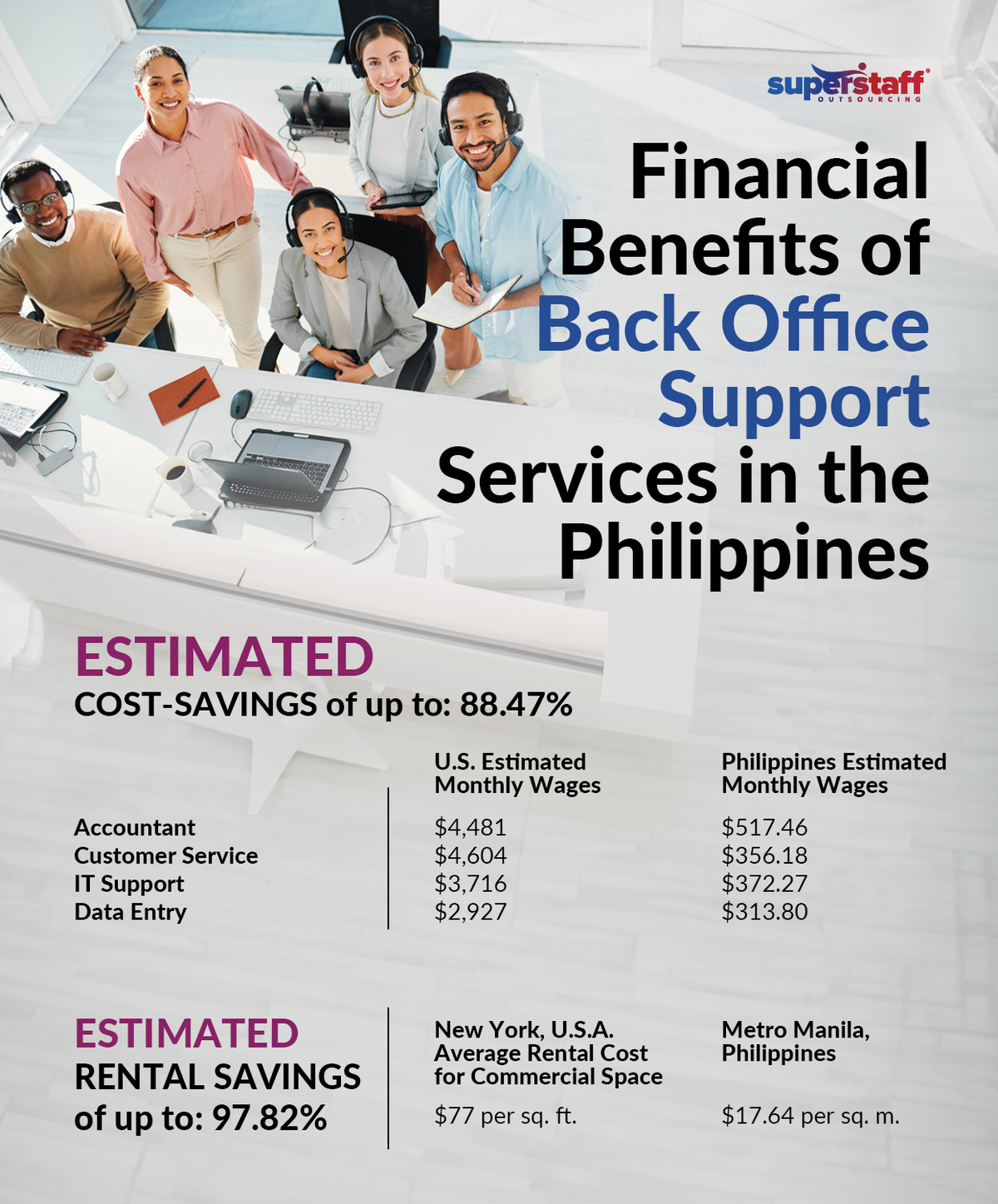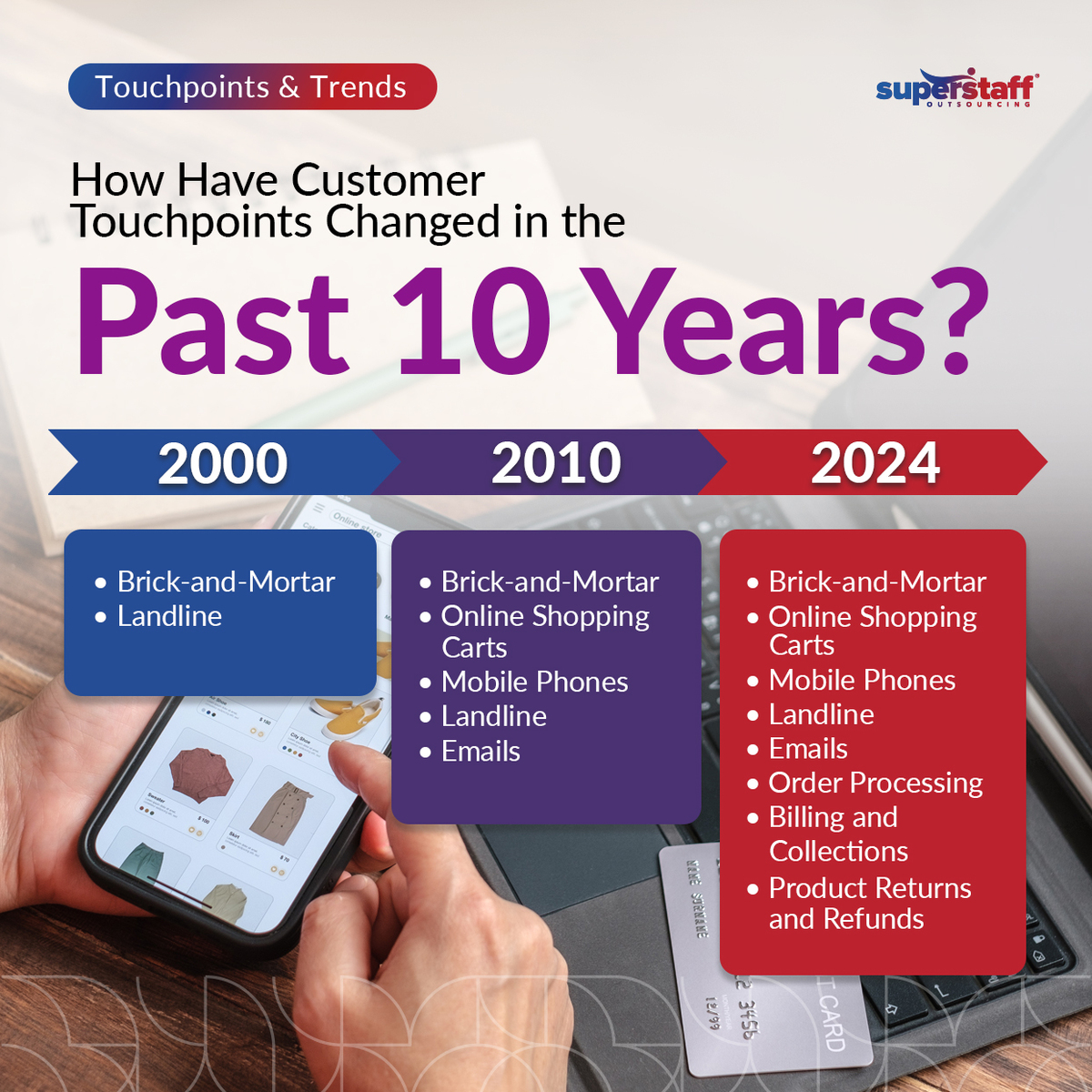
For decades, businesses have utilized back office outsourcing to streamline their operations. These roles used to be limited to non-client-facing, administrative, and routine tasks. Today, back office services have expanded and evolved to become more encompassing and impactful than they used to be, adding more value in the era of customer-centric solutions.
What has changed? The simple truth is that today’s customers have become more discerning when deciding on which brands to engage with and do business with. Securing your competitive edge means improving all aspects of your customer journey, including crucial back-office functions that directly and indirectly affect buyer experiences.
Past vs. Present: The Changing Role of Back Office Support
In the past, back office outsourcing was a function relegated to the background, sometimes forgotten and overlooked by some busy company leaders. Since they did not directly work with customers, these roles used to be considered less of a value add than product development and sales tasks. However, back office services have always been crucial for the success of any business, helping stabilize operations and drive all departments to maximum productivity.
Today, forward-thinking executives see the indispensable value of back office service solutions in enhancing operational efficiency and overall customer experience. Understanding the profound impact of these non-client-facing functions on customer satisfaction can help you increase competitiveness in the Customer-Centric Era.
What is customer-centricity?
In today’s modern business environment, customer-centricity is a key competitive differentiator. It is a strategic approach that essentially makes the customer the focal point of a business, meaning you must align your processes, systems, and actions with your buyers’ wants, goals, and preferences.
According to a Deloitte study, customer-centric companies are 60% more profitable than those that neglect buyer experiences. The goal should be to prioritize customer needs and expectations across all aspects of your operations, from the moment they first hear about your products or services to their post-sale experiences.
To achieve customer-centricity, you must understand what your consumers want and find ways to make their lives easier throughout each interaction with your brand. We recommend mapping out your customer journey and assessing which touchpoints would benefit from enhancement or improvement.
Here’s where back office process outsourcing fits the equation: Crucial back-end functions support customer touchpoints. Paying attention to these non-client-facing roles can help you create a more seamless and positive experience for your buyers throughout their entire brand journey.

Critical Touchpoints Where Back Office Outsourcing Is Significant in Promoting Customer-Centricity
Order Processing
Order processing is a critical touchpoint for businesses like yours, ensuring the right products are delivered to customers at the right time. Although different companies and industries may have varying workflows, the typical order processing system may look something like this:
Step 1: Order Placement and Verification
The first step begins when a customer orders through one of your official channels. They may use your e-commerce website, mobile app, social media, order forms, or any other platform. Your team of back-office support professionals will ensure accuracy by verifying customer information, payment details, location, and other critical data.
Step 2: Inventory Sourcing
Once order details are approved and processed, the next step is to check the item’s availability. Back-office specialists will coordinate with suppliers and warehouse managers for inventory sourcing. Then, they will gather all materials and items needed for the order and work with the delivery team to prepare the products for shipment.
Step 3: Picking and Packing
Proper packaging is essential to keep the products in good condition during transportation. Your inventory management team is responsible for selecting the items from warehouse shelves and carefully packing them in their appropriate containers before sending them out for shipping.
Step 4: Shipping
After the product has been packed, the order is handed to the supply chain and logistics team. While the delivery personnel transport the goods, a BPO dispatching specialist helps them find an optimal route to their destination on time.
Step 5: Order Tracking and Updates
All deliveries are monitored using cutting-edge tracking and tracing technology. Back office specialists will keep track of order status to inform customers about estimated delivery times or notify them of any delays or cancellations.
Step 6: Delivery
Once your delivery team reaches their intended destination, they’ll deliver the package right to your customers’ doorsteps. Sometimes, they may also help buyers install or assemble the products, such as when delivering large appliances or furniture.
Step 7: Post-Delivery Analysis
Delivering the product shouldn’t be the end of your interaction with the customer. To build better buyer relationships, you can send them feedback forms asking about their order and delivery experiences. Then, your outsourced data analyst can use the collected data to identify patterns and trends that can help you improve your overall customer journey.
Billing and Collections
The process of sending and receiving invoices may seem like a small task, but it is a critical customer experience touchpoint. Any billing statement discrepancies or errors can have enormous consequences on your brand’s reputation. Here is the typical process for billing and collections and how back office services can streamline it:
Step 1: Record Keeping
Before sending out an invoice, you must ensure that all information in the billing statement is accurate. Your data entry specialists will help you accurately record all transactions, correctly logging customer details, payment methods, and order information to prevent misunderstandings and disputes.
Step 2: Creating and Sending Billing Statements
Drawing from your customer database, billing and collection specialists will create detailed billing statements, complete with a clear breakdown of charges. They will then notify the customer about their outstanding balance before a specific due date to avoid late payments.
Step 3: Payment Processing
Ideally, your business will provide customers with multiple payment options so they can choose which is the most convenient for them. Your back-office team will be in charge of processing and verifying payments.
Step 4: Following Up on Overdue Payments
Billing and collection specialists closely monitor transactions to ensure all payments are made. Once they notice that a customer has not sent in their payment past the original deadline, they will promptly follow up with them and resolve the issue.
Product Returns and Refunds
Delivering a package isn’t always the end of a transaction. Research studies have shown that more than half (54%) of consumers say that a company’s return and exchange policies affect whether they will continue buying from that brand.
For instance, let’s zoom in on the consumer electronics industry. Sometimes, buyers may accidentally receive defective or damaged gadgets and contact you, asking for a return, exchange, or refund. Here’s how outsourcing back-office operations can help you handle this process:
Step 1: Creating a Clear Return and Refund Policy
The first step to ensuring a seamless return or exchange process is creating a detailed policy for your employees to follow. Let them know the specific conditions under which your company will allow returns, exchanges, or refunds so they can confidently navigate each transaction.
Step 2: Verifying Product Return Request
When a customer contacts you and asks for a refund or exchange, back-office professionals must first verify the request. They will assess whether the item was actually purchased from your store and whether the request meets particular conditions (for example, some consumer electronics stores may not allow refunds or exchanges for gadgets returned more than a certain number of months from the purchase date).
Step 3: Processing Return and Payment
Once all return details have been verified, your back office team will exchange the item or provide a refund. They can refund the order through the original payment method, through cash, or by giving store credits and vouchers.
Step 4: Returning Item to Inventory
Not all returned products are damaged or unusable. Some buyers ask for refunds simply because the item didn’t meet their expectations or they changed their mind after purchasing it. In these cases, your back office team may add the item to inventory, reselling it depending on product conditions and business rules.
Onboarding Customer Service
Customer service is an essential touchpoint in the Era of Customer-Centricity. It is often the first interaction many buyers will have with your business, influencing their decision to purchase or continue engaging with your brand.
According to Zendesk’s 2024 CX Trend Report, 70% of company leaders are reinventing their entire buyer journey, and 80% plan to do so by increasing their spending on customer service.
To build your ideal customer service team, you need the help of human resource (HR) professionals. These back-office outsourcing specialists can help you hire, train, and manage your workforce so they can focus on giving your customers the best possible service. Here’s an overview of the HR workflow:
Step 1: Hiring and Onboarding
Recruiters will create and send detailed job postings, screen and interview applicants, and narrow down the best candidates for you. Once you’ve selected from the pool of applicants, your HR team will handle the onboarding process for the new hires, which includes completing paperwork, communicating roles and responsibilities, and providing a quick company orientation.
Step 2: Training
You must invest in your customer service team’s training and development to ensure they are adequately equipped and prepared to handle all possible challenges. Qualified professionals will handle new hire training, empowering them to maintain a professional tone and consistent messaging when interacting with customers.
Step 3: Talent Management
Beyond recruitment and training, outsourced HR specialists also take on talent management responsibilities. Some of their tasks include prioritizing employee engagement initiatives, handling payroll, resolving employee disputes, and listening to worker feedback.
Feedback and Complaints Management
How well you respond to criticism can impact how your target market perceives your brand and influences whether they will continue to do business with you. Studies have found that 53% of consumers say companies don’t act on their feedback, leading to poor customer experiences. Here’s an overview of the feedback and complaints management process:
Step 1: Listen to Customer Complaints
Customers can send feedback through multiple channels like phone, email, social media, or even review websites and apps. Proactive businesses can ask for feedback directly through post-sale survey forms. No matter which platform your buyers use, make sure to have a dedicated team monitoring all complaints.
Step 2: Respond to Complaints
Once you’ve taken the time to listen to the feedback, responding to them and, more importantly, offering a solution should be your top priority. Some issues may be more complex than others, but acknowledging that you’ve heard their concerns and are working hard to fix them is essential for all interactions.
Step 3: Keep Track of All Feedback
Finally, keep an updated log of all customer complaints and feedback, noting which cases are resolved and which are ongoing. After collecting the data, you can work with a data scientist to identify root causes, spot trends, and develop strategies for improvement.

What Are the Most Commonly Outsourced Back Office Service Solutions?
No matter your specific business or industry, you can strengthen and streamline your operations by investing in back office support. Here are the specific tasks you can delegate to experienced offshore professionals:
Order Management
As mentioned in previous sections, companies, particularly retailers, often partner with back-office outsourcing companies to handle order processing and fulfillment. By leveraging the BPO firm’s expertise in supply chain, logistics, and inventory management, you can improve order visibility, ensure timely deliveries, and, in turn, keep your buyers happy.
- Order Receiving and Entry: Receive and log orders into a secure customer database.
- Order Verification and Validation: Review order information to check whether all details are correct and accurately logged.
- Inventory Check and Allocation: Monitor warehouse inventory to ensure enough raw materials and products are available to fulfill orders.
- Order Fulfillment and Packaging: Place products in a secure package and prepare them for shipment.
- Shipping and Delivery Logistics: Plan efficient routes to deliver products to their final destinations.
- Order Tracking and Status Updates: Inform customers about their orders and delivery status, notifying them of possible delays or cancellations.
- Payment Processing: Verify payment details and ensure the money is securely transferred.
- Returns and Exchanges Management: Handle post-sale disputes by offering returns, exchanges, or refunds.
Data Entry and Management
Believe it or not, data entry and management (often considered a “minor” back-office support task) is essential to every business transaction. Think of it this way: How will you make quick and efficient deliveries if you don’t know a customer’s name, address, preferences, and order specifications? What happens when a typographical error causes you to miss a delivery date or send goods to the wrong location?
A single error in data entry can quickly spell disaster for your business, causing confusion, misalignments, and conflict with your buyers. Unfortunately, customers may not be very forgiving of these mistakes. A recent PwC survey found that 59% of consumers will switch brands after several poor experiences, but 17% will turn away after just one lousy interaction.
Working with outsourced data entry specialists can help you avoid this issue entirely, enabling you to create and maintain an accurate and well-organized customer database. Here’s another perk: these offshore professionals work with quality control experts who meticulously review and verify information to facilitate a speedy and hassle-free order fulfillment process.
IT and Technical Support
Today’s customers prefer making purchases online without leaving the comfort of their homes, and they expect brands to deliver their products as quickly as possible. Technical support plays a decisive role in ensuring a seamless ordering process.
Research has found that 68% of companies agree that unplanned IT outages are the most significant cause of supply chain disruptions, often more troublesome than weather disturbances (62%), talent shortages (51%), and cyber-attacks (50%). These numbers suggest that technical problems significantly affect delayed deliveries and longer order fulfillment times.
Knowing this, investing in back office outsourcing roles like tech support, information technology (IT), and software development should be your top priority for improving overall customer experience.
If customers encounter a technical bug or issue with your e-commerce website or application, your tech support and help desk team will be ready and willing to assist them. They can guide new users through complex, time-sensitive, and urgent technical problems concerning order tracking, delivery, or payment processing.
At the same time, your IT staff will monitor your tech infrastructure and systems to minimize disruptions, prevent data breaches, and optimize your order management processes.
Logistics Support
Product and service deliveries are crucial to the customer experience, particularly for e-commerce and retail brands. According to a 2024 Gitnux Report, 88% of online shoppers expect their orders to be delivered in a week or less, and long wait times will cause 24% to abandon their carts or cancel their purchases.
Customers today care very deeply about their orders being delivered on time. They are no longer willing to wait for their purchases to arrive for long stretches of time, instead preferring speedy and even same-day deliveries.
Here’s the problem for businesses: The same Gitnux report found that order fulfillment is notoriously expensive, accounting for 70% of an e-commerce brand’s overall logistics costs. Many companies feel they must spend more to deliver their products to a customer’s doorstep on time.
Thankfully, partnering with a back office outsourcing company can help kill two birds with one stone, allowing you to make timely deliveries while saving on costs. According to the same research, 54% of companies agree that outsourcing e-commerce logistics support and fulfillment can significantly reduce operational costs.
Accounting and Bookkeeping
Beyond order management, data entry, and customer support, financial services are also among the most commonly outsourced back office service solutions. Many companies delegate accounting and bookkeeping functions to specialized BPOs so they can focus on their core business, while offshore professionals monitor all transactions and safeguard their financial health.
Billing and Collections
Studies have found that 70% of companies that provide detailed invoices and instructions experience improved payment times. At the same time, giving customers the option to use digital payment methods can reduce collection time by up to 30%, illustrating the importance of investing in cutting-edge financial software.
Outsourced billing and collection specialists have access to the latest financial technologies, allowing them to create and send accurate invoices that include detailed cost breakdowns, payment instructions, and other important information. This solution is particularly crucial for healthcare providers, allowing them to avoid medical billing errors and earn their patients’ trust and loyalty.
Empathetic Service
One mistake many leaders make is seeing billing and collections as a one-time transaction. The truth is that they are a central component of the customer experience, helping you nurture customer relationships and improve client satisfaction and retention.
When you work with a back office service provider in the Philippines, they can connect you with empathetic billing and collections specialists who can offer personalized communication, create clear and transparent invoices, and provide flexible payment options.
Recruitment Process Outsourcing
Building your ideal back office team can be a time-consuming process. Thankfully, the right recruitment process outsourcing provider can help you effortlessly attract and retain qualified professionals. They can also assist you in onboarding, training, and managing your team, resulting in more engaged, knowledgeable, and empowered employees who can give your clients the best possible experience.
The Rise of Specialized Back Office Outsourcing Services
In the past, BPO firms focused on providing generic outsourcing services, but the global landscape is changing, creating a shift to more specialized and industry-specific solutions. Today, outsourcing providers have expanded their capabilities to meet the particular needs of sectors like healthcare, e-commerce, AI development, technology, financial services, and law firms.
With these specialized BPO offerings, you can enjoy value-added services, leveraging expert insights and innovative strategies to solve your industry’s most pressing problems. Your outsourcing partner will keep up with changing regulatory requirements and legislation to help you make smarter business decisions.
Industry-Specific Solutions
BPO firms have expanded their solutions to cater to the particular needs of specialized sectors. From technology startups to medical institutions, businesses can find an outsourcing provider that can help them address their industry’s most pressing challenges.
- AI and ML Development Support: Accelerate artificial intelligence (AI) and machine learning (ML) development projects by delegating repetitive and time-consuming tasks to back-office professionals.
- Specialty Healthcare Outsourcing: Handle medical billing and coding, healthcare analytics, medical call center services, and other solutions for hospitals and clinics.
- Legal Process Outsourcing: Offload virtual paralegal services, litigation document review, legal research, and other tasks to an outsourcing firm.
The Financial Benefits of Customer-Centric Back Office Support Services
After zooming into the specific back office touchpoints you can invest in to improve CX, it’s time to spotlight the benefits of outsourcing these functions. When crafting your customer-centric business strategy, here’s why you should consider connecting with a BPO provider over hiring an in-house team:
Reduced Labor Costs
One of the biggest advantages of outsourcing back office operations is the significant cost savings. Compared to having an onshore team, working with offshore professionals can help you minimize salary, benefits, training expenses, and other overhead costs.
To illustrate this point, let’s look into some of the most in-demand back office professions and compare the average salary for that role in the United States vs. the Philippines (as of May 2024):
- Accountants: Their average monthly salary in the U.S. is $4,481, compared to only P30,009 or $517.46 in the Philippines.
- Customer Service Representatives: They earn $4,604 monthly in the U.S. and only an average of P20,656 or $356.18 in the Philippines.
- IT Support: These tech professionals earn a monthly average wage of $3,716, while their counterparts in the Philippines earn P21,589 or $372.27.
- Data Entry Clerks: In the U.S., data entry clerks earn $2,927 monthly, while Filipinos in the same role reap P18,198 or $313.80.
Source: Indeed
Companies that outsource their back office operations to an offshore location like the Philippines reap a massive financial benefit, lowering costs while retaining quality, productivity, and efficiency.
Lower Infrastructure Investment
Beyond labor costs, hiring offshore professionals to handle back office service solutions can also help reduce office space, utility, and other infrastructure expenses. U.S.-based companies can take advantage of the lower cost of living in countries like the Philippines and avoid shelling out a large portion of their financial resources on office rental and maintenance costs.
For instance, let’s say you plan on leasing an office space in New York. The average rental cost for commercial properties in the area would be $77 per square foot. If you want to move your headquarters to Los Angeles, you can get the cost down to $44 per sq. ft.
Meanwhile, renting commercial properties in the Philippines would require a much smaller investment. According to Statista, the average rental cost for a Grade A office space in Metro Manila would be P1,023 or $17.64 per square meter.
Economies of Scale
Finally, another financial advantage of back office outsourcing is that it allows companies to operate at economies of scale. By ramping up production and expanding your capabilities, BPO firms enable you to reduce cost per unit and enjoy greater flexibility and scalability.
This advantage is beneficial for businesses with fluctuating consumer demand. Through outsourcing, you can more easily adapt to changing consumer expectations and preferences, upgrading or downgrading operations to align with the market’s needs.
How to Choose the Right Back Office Business Process Outsourcing (BPO) Partner
We’ve established the significant financial benefits of outsourcing back-office services and the specific roles many companies delegate to offshore specialists. Now, it’s time to discuss how to choose your ideal BPO partner. Here are some of the considerations you should factor in when making your decision:
Vast Talent Pool and Strategic Locations
When choosing an offshore outsourcing provider, one essential factor is whether they have access to a large talent pool. Ideally, your BPO partner will be in an urbanized area with a massive population of dynamic, highly educated professionals.
Makati: The Philippines’ Premier Business District
When outsourcing back office operations to the Philippines, many leaders establish their headquarters in Makati City. As the country’s premier business district, the city has the largest concentration of commercial activities nationwide, accounting for 60% of Metro Manila’s office space inventory.
Makati is home to numerous tech startups, multinational corporations, and BPO companies. Because of the vast employment opportunities, the city has an estimated daytime population of 4.2 million. You can tap into this continually growing workforce and strengthen your back office departments.
Pampanga: The Countryside’s Most Investor-Friendly Business Hub
Today, companies are also beginning to see the advantages of investing in urban areas outside Metro Manila. Clark, Pampanga, is another strategic location for your outsourced operations. This investor-friendly economic hub is poised to become the future “Silicon Valley of the Philippines.”
Beyond Pampanga’s growing urban development, high-tech facilities, and modern IT infrastructure, the city also boasts a wealth of high-skilled young workers. Several premier universities are located in the province, producing a large pool of educated professionals ready to enter the workforce.
Aggressive Hiring and Training Timeline
Finding and hiring the right people is the next step in building your offshore back office support team. As talent shortages continue disrupting the job market in the United States and other Western economies, outsourcing to the Philippines has become an excellent strategic solution for addressing the labor crunch.
Philippine BPO companies have an advantage in talent acquisition, tapping into a massive workforce of qualified professionals who work for more cost-effective rates. To increase competitiveness, they also follow an aggressive hiring and training timeline, allowing them to fill roles faster than the industry average in the U.S.
Availability of Hybrid Outsourcing Models
Finally, another factor you should consider when searching for a BPO provider is whether they can help you implement hybrid outsourcing strategies. In the era of constant disruption, investing in only one location can be risky, making your operations more vulnerable to sudden, unforeseen crises like geopolitical issues or weather disturbances.
Adopting a hybrid offshore + nearshore strategy allows you to more easily adapt to changing economic and market conditions. It also gives your back office operations a buffer if one location faces disruption. You can invest in a small onshore team for your core operations while leveraging the cost benefits of offshoring and the time zone advantage of nearshoring.
Connect With a Reliable and Experienced Back Office Service Provider in the Philippines
Are you ready to modernize your administrative support functions and increase competitiveness in the customer-centric era? SuperStaff has your back.
From data entry and virtual assistant tasks to specialized and industry-specific solutions, we offer a wide range of back office outsourcing services to meet your business needs and goals. Our BPO solutions are flexible, customizable, and scalable, enabling you to adapt to constantly evolving consumer demands.
Contact us for a quick consultation, and let’s talk about what we can do for you!







